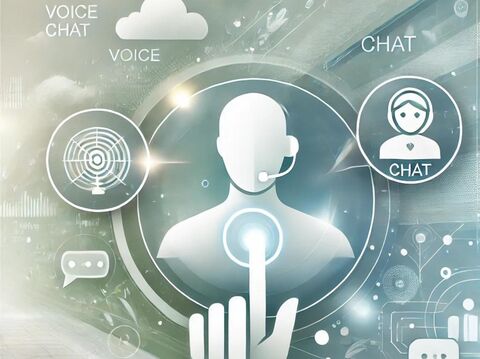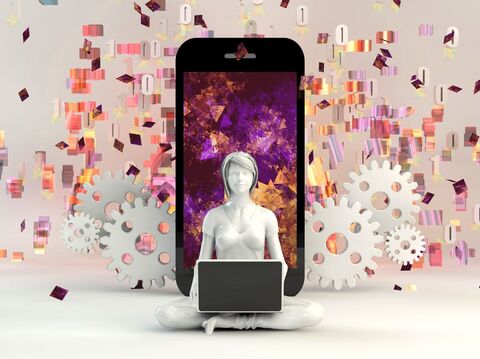Customer Connect: How Voice, Chat, and Video are Transforming the Digital Landscape

The mantra "Customer is King" has guided business philosophy for decades. In today’s digital era, the focus sharpens on ‘Customer Connect’ as the breakthrough. Advanced technologies like Voice, Chat and Video let businesses connect with customers more personally than ever.
Today, voice, chat, and video engagement are no longer in just communication channels. They are essential for how businesses connect with customers online. They provide smooth and customized modern customer service - that drives satisfaction and loyalty.
Let’s understand how the evolution of voice, chat, and video are changing the digital landscape.
How Modern Communication Technologies Redefine Interaction
Business-customer interactions are changing in a world where emoticons and GIFs are louder than words.
Let's reflect on a time when customer interactions were traditional and lacked personalization. Businesses used postal mail. They also used landline phones and in-person meetings to talk to their clients.
It constrained the depth of digital customer engagement. However, the internet changed this. It transformed how businesses interacted with customers forever.
The shift from traditional telephony to programmable voice and video represents a significant advancement in multi-channel communication. It moved from hardware-dependent systems to cloud software solutions.
Central to this evolution is Communication Platform as a Service (CPaaS). It offers developers APIs to seamlessly integrate voice, video, and messaging into applications and services.
Businesses now innovate faster, crafting customized customer experiences previously unthinkable in traditional ways.
For instance, JIO implemented a voice-based virtual assistant within their customer service platform. Customers can now resolve queries, manage accounts, and access services through simple voice commands.
From virtual assistants to voice-activated customer service, voice technology transforms business-customer engagement.
Today, customers can communicate with service providers more casually. They can search for information, purchase, or control smart home devices through voice-activated platforms.
How different industries are using the latest voice technology
- Retail Industry: Retailers are adding voice tech to their customer service. It gives customized help and recommendations.
For instance, Starbucks introduced voice ordering through its mobile app and virtual assistant. It allows customers to place orders and pay for their favorite drinks using voice commands.
- Hospitality sector: They use it to improve the guest experience and streamline operations at hotels and resorts.
Marriott International, for example, introduced voice-activated hotel rooms equipped with Amazon's Alexa. It allows guests to control room amenities, request services, and use voice commands.
- Healthcare Sector: Healthcare providers are adopting voice technology to enhance patient care and streamline administrative tasks.
Medical transcription services like Dragon Medical One- use speech recognition technology. It converts physician dictations into accurate medical records, saving time and reducing the risk of errors.
- Banking sector: Banks and financial institutions are using voice technology. It lets customers check their account balances, transfer funds, and even apply for loans using voice commands.
4 Latest Advances in Voice Technology
Here are some key developments and how businesses are using them to get a competitive edge:
Natural Language Processing (NLP)
NLP has advanced significantly, allowing voice assistants to correctly interpret and respond to human language.
Businesses use NLP-powered voice assistants to automate customer service. They use them to answer questions and give tailored suggestions based on consumer preferences.
Multi-Modal Interaction
Multi-modal interaction blends voice instructions with input types like touch and gesture. Businesses are exploring multi-modal interfaces for applications such as VR and AR.
It allows users to interact with digital worlds through voice commands and gestures.
Voice Biometrics
Voice biometrics technology verifies users' identities using their unique voice. Businesses like banking, finance, and healthcare are implementing voice biometrics solutions.
It ensures safe identification and fraud prevention.
AI-Driven Features in Voice
AI has advanced voice communication to a new level. Among the unique features are speech recognition, real-time translation, and automatic transcription. They pave the way for customization, efficiency, and scaling.
Chat support
In chat support, customers can connect with businesses in real time and receive instant responses to their questions.
From troubleshooting technical issues to tracking the status of an order, chat support is on standby 24/7.
4 Advanced Chat Technology Features and Benefits
Let’s look at how advanced chat technology is reshaping customer interactions:
-
Live Chat Support
Live chat help on websites is one of the most prominent use cases for chat technology in business. This service enables clients to contact a professional and receive assistance directly.
For example, suppose you are exploring an online store and have a query about a product. Start a chat window instead of waiting for an email or a call. Use it to talk with a rep in real time.
-
Messaging Apps
Besides live chat on websites, businesses use messaging apps. They use them to engage with their clients.
Platforms like WhatsApp and Facebook Messenger allow companies to interact with clients via their favorite chat medium.
For example, airlines may use WhatsApp. They use it to send passengers boarding passes and flight details.
-
AI-Powered Chatbots
AI has transformed chat technology, enabling the creation of intelligent chatbots capable of handling diverse customer queries.
These chatbots provide personalized support and automate repetitive work by using natural language processing (NLP) algorithms.
-
Chat Analytics
Chat analytics tools use advanced analytics and machine learning algorithms to analyze chat conversations. It extracts valuable insights about customer preferences, behavior patterns, and sentiment.
Businesses harnessing chat analytics can identify trends, track key metrics, and make data-driven decisions.
Video Communication
Customers can now interact face-to-face with businesses with a click.
For instance, you might have seen such CTAs on websites:
Need to consult with a financial advisor? Schedule a video call.
Want to get a virtual tour of your dream vacation destination? Schedule a video call.
Video interaction adds a personal touch to customer interactions, allowing businesses to forge deeper connections and build customer trust.
How Does Video Tech Enhance Customer Interaction?
Video tech makes customer interaction more personal and engaging. Here’s how:
-
Product Demonstrations and Virtual Tours
Thanks to video technology, businesses can now present their services in a more captivating and immersive manner. Instead of using static images, companies can make dynamic product videos.
For instance, a video that showcases the sleek design, intuitive interface, and advanced capabilities of a new smartphone.
-
Personalised Consultations and Support
Many companies now provide video consultations instead of phone conversations or emails. It enables clients to speak with specialists in person from anywhere in the world.
For instance, IT firms can provide remote technical support via video calls. It aids clients in debugging and resolving issues efficiently.
-
Interactive Webinars and Workshops
Video technology lets businesses host interactive webinars and workshops. They provide valuable educational content and foster community engagement.
For example, a marketing agency can host a live webinar on social media advertising. They can share tips and best practices with attendees in real-time.
-
Augmented Reality (AR) and Virtual Reality (VR)
Businesses are integrating AR and VR technologies into their applications to create immersive customer experiences. Businesses can use AR to overlay digital information onto real-world environments, enhancing product visualization and enabling virtual try-on experiences.
VR allows for immersive virtual tours and interactive presentations.
-
Video Analytics
The way companies study and understand AI-driven video analytics tools are changing video data. Using machine learning algorithms, these systems automatically identify and examine objects, persons, and actions in video.
For companies, this entails improving security monitoring, streamlining operational procedures, and obtaining insightful knowledge about consumer behavior.
Which Channel Should Drive Your Digital Transformation?
Businesses can integrate Voice, Chat, and Video into one platform. This integration allows customers to switch between channels effortlessly, leading to:
-
Enhanced Customer Experience.
-
Increased Accessibility.
-
Personalization and Relationship Building.
-
Efficient Issue Resolution.
-
Real-time Collaboration and Support.
-
Data Insights and Analytics.
To Sum Up
Voice, Chat, and Video technologies offer businesses unprecedented opportunities to connect with customers in more meaningful ways.
These technologies have come from traditional methods to cloud solutions. They allow seamless integration and personalised experiences.
Voice technology enables natural conversations. Chat support offers instant responses. Video adds a personal touch to interactions.
Advanced features like AI-driven chatbots, multi-modal interaction, and video analytics enhance customer engagement and satisfaction.
Growth Jockey demonstrates expertise in digital transformation. It plays a crucial role in this landscape.
Businesses can navigate the complexities of automating Voice, Chat, and Video channels using Growth Jockey's services. Growth Jockey helps businesses by providing smooth interactions and customized experiences. This helps them build better relationships with their customers. It sets the foundation for long-term success.
Growth Jockey: Your Partner in Digital Transformation
-
Expertise in Digital Transformation
-
Navigating Complexity
-
Enhanced Customer Experiences
-
Efficient Issue Resolution
-
Driving Growth
FAQs
1. What role does voice technology play in customer engagement?
Voice technology allows natural and informal interactions. It enables tasks such as searching for information, purchasing and controlling smart devices with voice commands.
2. How can businesses measure the success of their customer connection strategies?
Businesses can use metrics. Metrics include customer satisfaction scores, response times, conversion rates, and customer feedback. They help test the effectiveness of communication.
3. Why is multichannel communication important for businesses?
Combining voice, chat, and video into one platform allows customers to switch between channels. This improves access, personalization, and issue resolution.
4. What are some key developments in voice, chat, and video technologies?
Developments include advances in natural language processing. They also include better voice quality, multi-modal interaction, voice biometrics, and AI-driven features like virtual assistants.








